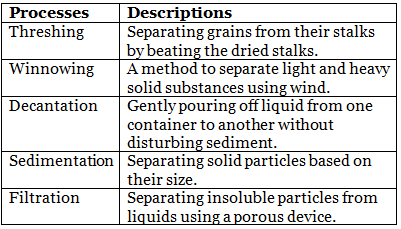Separation of Substances Class 6 Worksheet Science Chapter 3
Q1: Multiple Choice Questions (MCQs)
(i) What is the primary purpose of sieving?
(a) To separate insoluble solids from liquids.
(b) To separate solid substances that differ in size.
(c) To separate immiscible liquids.
(d) To dissolve solid particles in a liquid.
Ans: (b)
Sieving is used to separate solid substances based on their size.
(ii) What is the outer covering of seed grains that can be separated using winnowing?
(a) Salt
(b) Chaff
(c) Sugar
(d) Sand
Ans: (b) Chaff
Winnowing is used to separate lighter substances like chaff from heavier grains.
(iii) What is the process of gradually pouring off liquid from one container to another without disturbing the sediment called?
(a) Loading
(b) Decantation
(c) Sedimentation
(d) Filtration
Ans: (b)
Decantation is the process of pouring off liquid without disturbing the settled sediment.
(iv) What is a saturated solution?
(a) A solution with very little solute.
(b) A solution that cannot dissolve more solute at a given temperature.
(c) A solution with equal amounts of solute and solvent.
(d) A solution with the highest solubility.
Ans: (b)
A saturated solution cannot dissolve more solute at a specific temperature.
(v) How does temperature affect the solubility of a solute in a solvent?
(a) It decreases solubility.
(b) It has no effect on solubility.
(c) It increases solubility.
(d) It changes the color of the solution.
Ans: (c)
Solubility generally increases with higher temperatures.
Q2: Fill in the Blanks
(i) Separation of different-sized solid particles is achieved through a process called _______________.
Ans: sieving
(ii) Immiscible liquids can be separated using the method of _______________.
Ans: decantation
(iii) Sedimentation allows the separation of undissolved solid particles from a liquid, where the solid particles settle at the _______________ of the container.
Ans: bottom
(iv) The process of separating salt from seawater is known as _______________.
Ans: evaporation
(v) Loading is used to separate tiny, suspended solid particles in a liquid by adding a substance like _______________.
Ans: alum
Q3: Match the Column (In a Table)
Match the processes on the left with their descriptions on the right. Ans:
Ans:
Q4: True or False
(i) Sedimentation allows the separation of dissolved solid particles from a liquid.
Ans: False
Sedimentation separates undissolved solid particles.
(ii) Loading is used to separate tiny, suspended solid particles in a liquid.
Ans: True
Loading helps separate extremely small insoluble particles.
(iii) Immiscible liquids are liquids that mix together to form a single layer.
Ans: False
Immiscible liquids do not mix and form separate layers.
(iv) Solubility increases with a decrease in temperature.
Ans: False
Solubility generally increases with higher temperatures.
(v) Decantation is used to separate solid particles based on their size.
Ans: False
Decantation is used to separate liquids from settled solids without disturbing the sediment.
|
22 videos|80 docs|16 tests
|
|
22 videos|80 docs|16 tests
|

|
Explore Courses for Class 6 exam
|

|
















